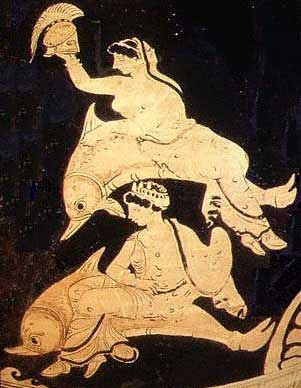
Thetis on a Hippokampos
The Nereids were a collection of fifty sea nymphs who were the daughters of Doris and Nereus, the old man of the sea. They originated in Greek mythology, however migrated to later Roman mythology like most Greek figures. The Nereids were seen as the protectors of sailors and fisherman, who would come to the aid of those in distress in the water. They appear in the Argonautica as helping the Argonauts through their search for the Golden Fleece.
Each nymph was said to have represented a different aspect of the ocean. These aspects include the sea foam, the sand and the waves. All fifty nymphs were told as living with Nereus in a grotto-palace at the bottom of the Aegean Sea, and could be called upon in a time of need. The eldest daughter Thetis was the unofficial leader, with her sister Galatea being the love interest of the Cyclope Polyphemus. Their sister Amphitrite was known as Poseidon’s queen and as such, they are often seen accompanying him.
The Nereids appear as a secondary character in many prominent hero stories in classical mythology. They are covered by a wealth of writers such as Apollodorus, Homer, Ovid, Hesiod and Hyginus. An example of this is seen in Homer’s Iliad, where Thetis and her sisters appear in sympathy to Achilles. Thetis was his mother, and upon hearing of his grief at the death of Patroclus, she rallies the Nereids to appear next to him and console him.
Another example is created by Apollodorus in his Bibliotheca. In this he writes that Queen Cassiopea challenged the Nereids to a beauty contest. This slight enraged both the Nereids and Poseidon who in his anger, sent a monster to invade the island. Andromeda was the daughter of Queen Cassiopea and King Cepheus of Phoenicia, who was offered as a sacrifice to quell the rage of the monster. The hero Perseus fell in love with Andromeda and promised to kill the monster. After he did so, Hermes restored the pride of the Nereids.
They also briefly feature in the Argonautica by Apollonius Rhodius. In this, Thetis calls her sisters to the aid of her husband Peleus in order to protect the Argo from the rocks and other trials in the seas.
The Nereids were depicted in ancient art as being beautiful, young human maidens. They would also be shown riding the back of sea creatures. Many depictions have caused a confusion, as the tail of the sea creature appears to be connected to the women. This has led to modern interpretations showing the Nereids as resembling Mermaids instead. This confusion has only been heightened with the descriptions of their singing abilities.
-Devon Allen
Junior Girl
Girl Museum Inc.
